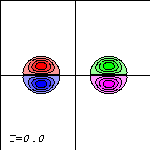
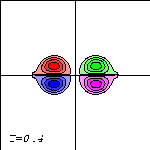

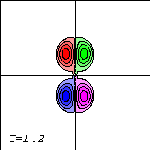
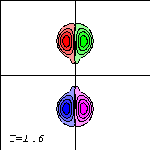
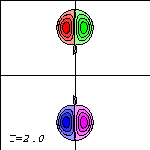
(You can click on an image for a somewhat larger version;
each is about 3.2 kb.)







(You can click on an image for a somewhat larger version;
each is about 3.2 kb.)
The two Lamb dipoles are initially (top-left picture) placed with their axes along the x-axis in such a way that they move towards each other (top-centre). During this motion a small tail is formed in the wake of each dipole. At a certain moment they hit each other and deform. In the top-right picture the four extrema of vorticity are closest together and from one vortex structure consisting of four patches of vorticity (a 'quadrupole'). This configuration is not stable and it falls apart in two dipole moving in opposite direction along the y-axis (bottom-left): there has been an exchange of partners. The newly formed dipoles now move away from each other (bottom-centre) and gradually assume the structure and characteristics of two Lamb dipoles again (bottom-right), leaving behind a little vorticity in their wakes.
The motion of the Lamb dipoles is computed with a Finite Difference Method which solves the two-dimensional vorticity (Navier-Stokes) equation. Time and distances are given in dimensionless units. What you see in the simulation above are lines of tracers: passive 'particles' that advection by the motion. In this particular case, the tracers are placed on streamlines of the Lamb dipole.
===> Some details on the computation presented on this page for those who are interested.
<=== Numerical simulations of 2D vortex evolution with a Finite Difference Method.
 Jos van Geffen --
Home |
Site Map |
Contact Me
Jos van Geffen --
Home |
Site Map |
Contact Me